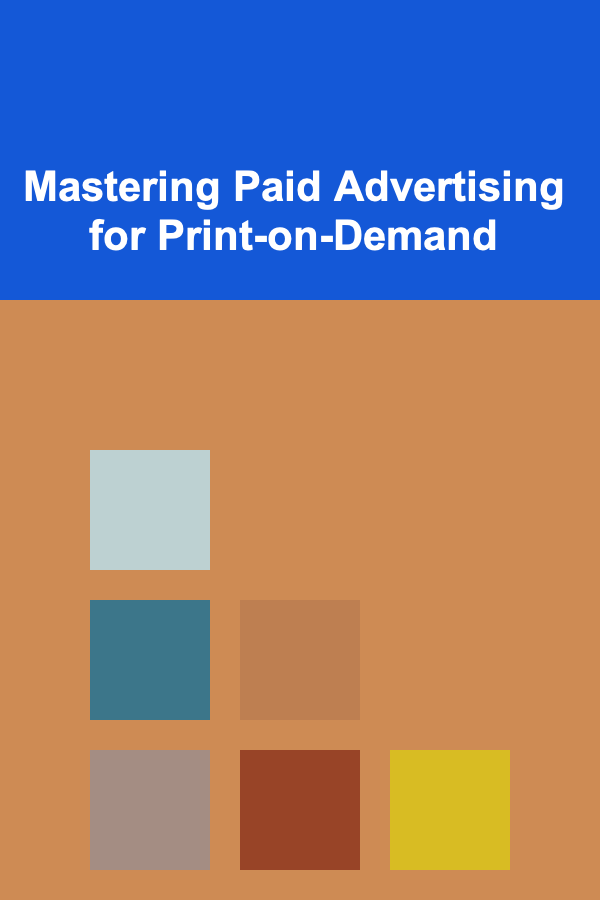
Mastering Paid Advertising for Print-on-Demand
ebook include PDF & Audio bundle (Micro Guide)
$12.99$7.99
Limited Time Offer! Order within the next:

Print-on-demand (POD) has revolutionized the e-commerce landscape, enabling individuals and businesses to sell custom-designed products without holding any inventory. While the ease of entry is a significant advantage, standing out in the crowded POD market requires a robust marketing strategy. Paid advertising is often the quickest and most effective way to drive traffic to your POD store and generate sales. However, simply throwing money at ads is a recipe for disaster. Success with POD advertising hinges on a deep understanding of your target audience, compelling product design, effective ad creatives, strategic platform selection, and relentless optimization.
Understanding the Print-on-Demand Landscape
Before diving into paid advertising, it's crucial to understand the unique challenges and opportunities of the POD model. Here are key considerations:
Profit Margins
POD margins are generally lower than traditional retail. Production costs, platform fees, and advertising expenses all eat into your profits. This necessitates careful cost management and efficient advertising strategies. You need to know your cost of goods sold (COGS) including platform fees and shipping to accurately calculate your profit margin and determine a viable cost per acquisition (CPA).
Product Quality and Selection
The quality of POD products can vary significantly depending on the provider. Order samples from multiple providers and rigorously test their products before committing. Offer a curated selection of high-quality products that align with your brand and target audience. Don't try to be everything to everyone; focus on a niche and excel.
Branding and Customer Experience
Building a strong brand is essential for long-term success in the POD space. Create a professional website, develop a unique brand voice, and provide excellent customer service. Invest in high-quality product mockups and lifestyle photography to showcase your designs effectively. Pay close attention to the unboxing experience, as this is often the first tangible interaction customers have with your brand.
Market Research
Thorough market research is paramount. Identify your target audience, understand their interests and preferences, and analyze your competitors. Use tools like Google Trends, social media analytics, and keyword research tools to gain insights into market trends and customer behavior. Understanding trends allows you to capitalize on timely events and interests, creating more appealing and relevant designs.
Choosing the Right Advertising Platforms
Selecting the right advertising platform is critical for reaching your target audience and maximizing your return on investment (ROI). Here are some of the most popular and effective platforms for POD advertising:
Facebook and Instagram Ads
Facebook and Instagram offer unparalleled targeting capabilities, allowing you to reach specific demographics, interests, and behaviors. They are visual platforms ideal for showcasing your designs and products. Key features include:
- Detailed Targeting: Target users based on demographics, interests, behaviors, connections, and more.
- Lookalike Audiences: Create audiences that resemble your existing customers to expand your reach.
- Retargeting: Re-engage users who have previously interacted with your website or ads.
- Visual Ad Formats: Utilize images, videos, carousels, and collection ads to showcase your products effectively.
- A/B Testing: Experiment with different ad creatives, copy, and targeting options to optimize performance.
Strategies for Success:
- High-Quality Visuals: Invest in professional product photos and videos that showcase your designs in the best possible light. Consider lifestyle photos and videos that demonstrate how your products can be used in real-world scenarios.
- Compelling Ad Copy: Write concise and persuasive ad copy that highlights the unique benefits of your products. Use a clear call to action (CTA) to encourage users to click and purchase.
- Audience Segmentation: Segment your audience based on interests, demographics, and behaviors to deliver more relevant ads. For example, you might create separate campaigns for dog lovers, cat lovers, and outdoor enthusiasts.
- Regular Optimization: Continuously monitor your ad performance and make adjustments to improve your ROI. Test different ad creatives, copy, and targeting options to identify what works best.
- Leverage User-Generated Content (UGC): Encourage customers to share photos and videos of themselves using your products and feature this content in your ads. UGC can be incredibly effective in building trust and social proof.
Google Ads (Search and Shopping)
Google Ads allows you to reach customers who are actively searching for products like yours. It's a powerful platform for driving targeted traffic to your website. Key features include:
- Keyword Targeting: Target users based on the keywords they search for on Google.
- Shopping Ads: Showcase your products directly in Google Search results with images, prices, and product titles.
- Text Ads: Create compelling text ads that highlight the benefits of your products and encourage users to click.
- Location Targeting: Target users based on their geographic location.
- Remarketing Lists for Search Ads (RLSA): Target users who have previously visited your website with tailored search ads.
Strategies for Success:
- Keyword Research: Conduct thorough keyword research to identify the most relevant and profitable keywords for your products. Use tools like Google Keyword Planner and SEMrush to discover high-volume, low-competition keywords.
- Optimized Product Listings: Create optimized product listings with accurate titles, descriptions, and high-quality images. Ensure that your product listings are consistent with your website content.
- Compelling Ad Copy: Write clear and concise ad copy that highlights the key features and benefits of your products. Include a strong call to action.
- Bidding Strategy: Choose the right bidding strategy to maximize your ROI. Consider using automated bidding strategies like Target CPA or Target ROAS.
- Ad Extensions: Use ad extensions to provide additional information about your products and your business. Ad extensions can include sitelinks, callouts, and location information.
Pinterest Ads
Pinterest is a visual discovery platform that's ideal for showcasing your POD products, especially those related to fashion, home decor, and lifestyle. Key features include:
- Visual Search: Users discover products through visual search and recommendations.
- Targeting Options: Target users based on interests, keywords, and demographics.
- Shopping Ads: Display products directly within Pinterest search results and boards.
- Rich Pins: Provide additional information about your products, such as pricing and availability.
- Collection Ads: Showcase multiple products in a single ad format.
Strategies for Success:
- High-Quality Images: Use visually appealing and high-resolution images that showcase your products in an aspirational way.
- Keyword Optimization: Optimize your pin titles and descriptions with relevant keywords.
- Targeted Boards: Create targeted boards that align with your product categories and target audience interests.
- Promoted Pins: Promote your pins to reach a wider audience and drive traffic to your website.
- Stay on Trend: Monitor trending topics on Pinterest and create pins that are relevant to those trends.
TikTok Ads
TikTok, with its massive Gen Z and Millennial user base, offers a unique opportunity to reach a younger demographic. Its short-form video format is perfect for showcasing your POD products in a creative and engaging way. Key features include:
- Short-Form Video Ads: Create short, engaging videos that capture attention quickly.
- Targeting Options: Target users based on demographics, interests, and behaviors.
- In-Feed Ads: Display ads in the "For You" feed, seamlessly integrated with organic content.
- Brand Takeover Ads: Take over the app for a day with a full-screen ad. (This is a higher-cost option.)
- Hashtag Challenges: Encourage users to create content related to your brand or products.
Strategies for Success:
- Authentic Content: Create authentic and engaging content that resonates with the TikTok audience. Avoid overly promotional or salesy content.
- Trending Sounds: Use trending sounds and music in your videos to increase visibility.
- User-Generated Content: Encourage users to create content featuring your products and repost it on your page.
- Influencer Marketing: Partner with TikTok influencers to promote your products to their followers.
- Experiment with Formats: Experiment with different video formats, such as tutorials, behind-the-scenes footage, and product demonstrations.
Creating Effective Ad Creatives
Your ad creatives are the first thing potential customers will see, so it's crucial to make a strong impression. Focus on creating visually appealing and compelling ads that grab attention and communicate the value of your products.
High-Quality Visuals
Invest in professional product photography and videography. Use high-resolution images and videos that showcase your designs in the best possible light. Consider using lifestyle photos and videos that demonstrate how your products can be used in real-world scenarios. Ensure that your visuals are consistent with your brand aesthetic.
Compelling Ad Copy
Write concise and persuasive ad copy that highlights the unique benefits of your products. Use a clear call to action (CTA) to encourage users to click and purchase. Focus on the problem your product solves or the desire it fulfills. Use strong verbs and evocative language to create a sense of urgency and excitement. Tailor your ad copy to the specific platform and audience you're targeting.
A/B Testing
Constantly experiment with different ad creatives, copy, and targeting options to optimize performance. A/B test different headlines, images, and CTAs to see what resonates best with your audience. Use the data to make informed decisions about your ad campaigns. Tools like Facebook Ads Manager and Google Ads allow you to easily create and track A/B tests.
Understand Platform Best Practices
Each platform has its own best practices for ad creatives. For example, Instagram ads should be visually stunning, while Google search ads should be highly relevant to the search query. Research each platform's guidelines and adapt your creatives accordingly.
Targeting the Right Audience
Reaching the right audience is essential for maximizing your advertising ROI. Here are some key targeting strategies for POD products:
Demographic Targeting
Target users based on age, gender, location, education, and other demographic factors. This is a good starting point for many campaigns, but it's important to layer on additional targeting options for more precise results.
Interest Targeting
Target users based on their interests and hobbies. This is a powerful way to reach people who are likely to be interested in your products. For example, if you're selling t-shirts with dog designs, you can target users who have expressed an interest in dogs, dog breeds, or dog-related activities.
Behavioral Targeting
Target users based on their online behavior, such as websites they visit, products they purchase, and ads they click. This can be a highly effective way to reach people who are actively shopping for products like yours. For example, you can target users who have recently visited e-commerce websites or who have purchased similar products in the past.
Lookalike Audiences
Create lookalike audiences based on your existing customers to expand your reach. Lookalike audiences are users who share similar characteristics and behaviors with your current customers, making them highly likely to be interested in your products. This is a powerful strategy for scaling your ad campaigns.
Retargeting
Retarget users who have previously interacted with your website or ads. Retargeting allows you to re-engage users who have shown interest in your products but haven't yet made a purchase. This can be a highly effective way to increase conversions. Common retargeting strategies include showing ads to users who have visited specific product pages, added items to their cart, or abandoned their checkout process.
Tracking and Analyzing Results
Tracking and analyzing your ad performance is crucial for optimizing your campaigns and maximizing your ROI. Use the analytics tools provided by each advertising platform to monitor key metrics such as:
- Impressions: The number of times your ads have been displayed.
- Clicks: The number of times users have clicked on your ads.
- Click-Through Rate (CTR): The percentage of impressions that resulted in clicks. (Clicks / Impressions) * 100
- Cost Per Click (CPC): The average cost you pay for each click on your ads. (Total Ad Spend / Clicks)
- Conversions: The number of sales or other desired actions that resulted from your ads.
- Conversion Rate: The percentage of clicks that resulted in conversions. (Conversions / Clicks) * 100
- Cost Per Acquisition (CPA): The average cost you pay for each conversion. (Total Ad Spend / Conversions)
- Return on Ad Spend (ROAS): The amount of revenue you generate for every dollar you spend on advertising. (Revenue from Ads / Total Ad Spend)
Use this data to identify which ad creatives, targeting options, and platforms are performing best. Make adjustments to your campaigns based on your findings to improve your ROI. Regularly review your data to spot trends and optimize accordingly. Look for patterns in successful campaigns and replicate them, while eliminating or modifying underperforming ones.
Budget Management and Optimization
Effective budget management is essential for sustainable advertising success. Start with a clear understanding of your profit margins and customer acquisition cost (CAC) goals. Set a realistic daily or lifetime budget for each campaign and monitor your spending closely.
Starting Small and Scaling
Begin with small test campaigns to validate your assumptions and gather data. Once you identify winning strategies, gradually scale your budget and expand your reach. Avoid making drastic budget increases, as this can disrupt your campaign performance.
Bidding Strategies
Experiment with different bidding strategies to find the optimal balance between cost and performance. Manual bidding allows you to control your bids directly, while automated bidding strategies use machine learning to optimize your bids for you. Consider using Target CPA or Target ROAS bidding strategies to maximize your ROI.
Regular Monitoring and Adjustments
Continuously monitor your campaign performance and make adjustments as needed. Pause or modify underperforming ads and targeting options. Reallocate your budget to campaigns that are generating the highest ROI. Pay attention to seasonality and adjust your budget accordingly.
Legal and Ethical Considerations
Ensure your advertising practices comply with all applicable laws and regulations. Avoid making misleading or deceptive claims about your products. Be transparent about your pricing and shipping policies. Respect user privacy and data security. Comply with the advertising policies of each platform you use.
Copyright and Trademark
Avoid using copyrighted or trademarked material in your designs or ads without permission. Conduct thorough research to ensure that your designs are original and do not infringe on the intellectual property rights of others. Obtain necessary licenses and permissions when required.
Privacy and Data Security
Protect user privacy and data security by implementing appropriate security measures. Comply with data privacy regulations such as GDPR and CCPA. Be transparent about how you collect and use user data. Obtain user consent when required.
Long-Term Strategies
Paid advertising is not a silver bullet. It's essential to complement your paid advertising efforts with long-term strategies that build brand awareness, customer loyalty, and organic traffic.
Content Marketing
Create valuable and engaging content that attracts and educates your target audience. Blog posts, articles, videos, and social media content can help you establish yourself as an authority in your niche and drive organic traffic to your website. Focus on providing information that solves your customers' problems and answers their questions.
Email Marketing
Build an email list and nurture your subscribers with valuable content and exclusive offers. Email marketing is a powerful way to build relationships with your customers and drive repeat sales. Segment your email list based on customer interests and behaviors to deliver more relevant messages. Consider using email marketing automation to streamline your communication efforts.
Social Media Marketing
Build a strong presence on social media platforms that are relevant to your target audience. Share engaging content, interact with your followers, and run contests and promotions. Use social media to build brand awareness, drive traffic to your website, and generate leads. Focus on providing value to your followers and building a community around your brand.
SEO (Search Engine Optimization)
Optimize your website and content for search engines. SEO helps you improve your organic search rankings and drive more traffic to your website. Conduct keyword research, optimize your website structure, and build high-quality backlinks. Focus on providing a great user experience and creating valuable content that satisfies user intent.
Conclusion
Mastering paid advertising for print-on-demand requires a multifaceted approach that encompasses a deep understanding of the POD landscape, strategic platform selection, compelling ad creatives, precise targeting, meticulous tracking and analysis, and ethical considerations. By implementing the strategies outlined in this guide, you can effectively drive traffic to your POD store, generate sales, and build a thriving online business. Remember that success in POD advertising is an ongoing process of learning, testing, and optimization. Stay adaptable, embrace innovation, and never stop striving to improve your results.

How to Balance Growth and Security in Your Investment Portfolio
Read More
How to Build a Loyal Customer Base for Your Handmade Crafts
Read More
How to Choose the Right Art Pieces for Staging Your Home
Read More
How to Create a Signature Drink for Your Home Party
Read More
How To Understand the Global Coffee Market
Read More
Grasping the Concepts of Gene Flow
Read MoreOther Products

How to Balance Growth and Security in Your Investment Portfolio
Read More
How to Build a Loyal Customer Base for Your Handmade Crafts
Read More
How to Choose the Right Art Pieces for Staging Your Home
Read More
How to Create a Signature Drink for Your Home Party
Read More
How To Understand the Global Coffee Market
Read More